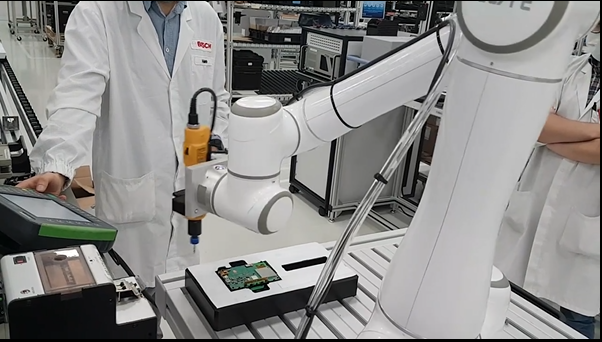01 Introduction
The ODM electronics manufacturer from Jiaxing issued a request for quotation regarding the application of collaborative robots on existing production lines for the purpose of improving production efficiency. In contrast to the automotive industry, which puts a premium on “robot safety”, users in 3C electronics manufacturing companies place greater emphasis on “rate” and “accuracy”, believing that these are the fundamental reasons for implementing robots.
The client’s production line is characterized by relatively low automation, requires high labor input, covers many cast product types and a short product life cycle. The client wishes to urgently limit personnel and increase output through automation. He selected the laser engraving process of housings for replacement of humans with robots.
02 Problematic issues
Every person is responsible for loading and unloading the laser engraver. For this reason, the plant is filled with dozens of laser engraving workstations. The actions performed by workers are repetitive, and a strong odor is emitted during engraving. The engraving equipment also utilizes various communication interfaces due to the presence of equipment in various models and from different manufacturers. How can a robot be introduced into a small space in order to replace human workers while simultaneously providing for loading and unloading of materials at different workstations? Industrial robots with protective fencings are not capable of performing these actions in the same space. Furthermore, it is also necessary to provide space for regular maintenance of engraving machines and other equipment. For this reason, the application of a traditional robot in this workstation does not make sense, and lightweight collaborative robots are indisputably a better solution.
03 The Solution
The EC66 collaborative robot with 6 kg lifting capacity can show its advantages in this project: 1. Guaranteed space and practicality; 2. The cobot’s workstation is lightweight and small, thanks to which it can be changed rapidly; 3. The collaborative robot is equipped with its own interface, network communication, a bus, as well as analog and digital inputs and outputs, allowing for quick and flexible integration between machines, facilitating automation and preservation of output while improving the system’s stability. Although the output per unit is lower than in the case of manual work, general production throughput is maintained when total work hours are taken into account.
- The ELITE EC66 collaborative robot was chosen, characterized by safety and low energy consumption
- Each EC66 is responsible for loading and unloading 2 laser engravers
- Two-station tray lifter, two-position suction mechanism
- An integrated base for equipment allows for simple maintenance and error removal
In this scenario, the main advantages of applying collaborative robots is flexible layout, high capacity for adaptation, low requirements concerning installation and open interfaces. In comparison to traditional robots, the introduction of cobots does not require any change to the existing production line’s configuration and occupies only 1 – 1.5 workstations. * Note: Due to restrictions on the possibility of publishing photographs from production in the 3C industry, let us look at a video of analogous applications.
